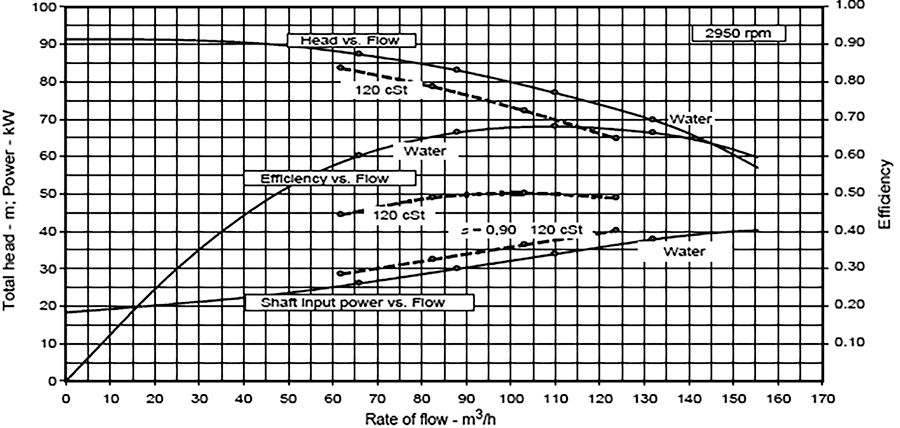
What effect does pumping a high viscosity fluid have on the pump system?
When a highly viscous liquid such as a heavy oil is pumped by a rotodynamic pump, the performance can be significantly changed in comparison to performance with water, due to increased losses. This performance reduction can be estimated by applying correction factors for head, rate of flow and efficiency to the performance with water. These correction factors determine the head and efficiency curves for the pump when handling viscous liquids.
Viscous correction factors are defined in Equation 1 (CH for head, CQ for flow, and Cη for efficiency):

These correction factors are used to correct the water performance to viscous performance. The ANSI/HI 9.6.7 Rotodynamic Pumps–Guideline for Effect of Liquid Viscosity on Performance establishes these correction factors based on empirical data for viscosities up to 3,000 centistokes (cSt), but allows the procedures to be used up to 4,000 cSt with increased uncertainty. The correction factors are based on the “B” parameter calculation. This considers the fluid viscosity, pump total head, flow rate at best efficiency and the rotation speed.
Image 1 is an example of water test data for total head, power and efficiency with respect to flow rate corrected for the viscous liquid that will be used in the process. Note that head, flow and efficiency will decrease with the increased viscosity, and the pump input power will have a corresponding increase.
 Image 1. Example performance chart for single-stage rotodynamic pump (Image courtesy of Hydraulic Institute)
Image 1. Example performance chart for single-stage rotodynamic pump (Image courtesy of Hydraulic Institute)For positive displacement (PD) pumps, this same relationship is not applicable. The physics of how PD pumps and rotodynamic pumps operate is different. PD pumps will behave differently than rotodynamic pumps handling viscous liquids. Rotodynamic pumps have an impeller that increases the velocity of the liquid to induce flow, but PD pumps capture a volume of liquid and transfer it directly during every revolution of the shaft.
In PD pumps, a certain amount of volume of liquid will leak (called slip) to a lower pressure region. Increased viscosity can reduce the amount of slip, which can result in increased output flow per shaft revolution, and an increase the volumetric efficiency of the PD pump. This increase in volumetric efficiency is offset by other mechanical and friction losses. The PD pump manufacturer should be consulted about the predicted or actual viscous performance characteristics.
For more information on the viscous performance of rotodynamic pumps, refer to ANSI/HI 9.6.7 at www.pumps.org.


